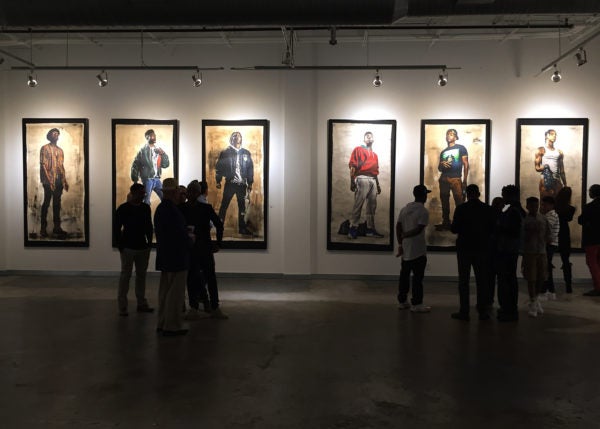
“Herein lies the tragedy of the age: not that men are poor—all men know something of poverty; not that men are wicked—who is good? Not that men are ignorant—what is the truth? Nay, but that men know so little of men.”
— W.E.B. Du Bois, The Souls of Black Folk
The year 2016, like so many before it, was not kind to black men. The police violence against black men that is increasingly caught on camera has created a horrifying video catalogue of black death. That, combined with the fact that we have a new president who unabashedly maligns black communities, makes clear that our societal understanding and treatment of black men is severely damaged. It is from within this cultural context that viewers may have encountered Joshua Rashaad McFadden‘s exhibition “Come to Selfhood” at Mason Fine Art.

Viewers were immediately greeted by six slightly larger-than-life-size photographs of black men from McFadden’s project Come to Selfhood. There was no accompanying text to inform the viewer of McFadden’s process or material, but each appears to be an archival print that McFadden has covered in a gold watercolor. The works hung above eye-level, forcing the viewer to gaze upward to look into the subjects’ eyes. Each figure seems to float on the paper. There’s no background or landscape to root them in a specific time or place, and the gold wash gives each piece the feeling of Byzantine nobility.

McFadden, who earned his MFA from SCAD-Atlanta in 2016, is part of a long line of artists who exalt black men in and through portraiture. McFadden’s large-scale men are distinguished from those by such artists as Kehinde Wiley or Fahamu Pecou by their ordinariness. Whereas Wiley’s painted portraits intentionally appropriate heroic Renaissance portraiture, and Pecou’s self-portraits alternately reference hip-hop hypermasculinity and Yoruba spirituality, McFadden’s men couldn’t be more common; it’s easy to imagine running into them in Atlanta.
Flanking the six portraits were works from McFadden’s series Come to Selfhood. Each work is a framed triptych of sorts, comprising a studio portrait of a young black man, a snapshot of his father, and text. The snapshots of the fathers in each work are somewhat aged, as if pulled from a family photo album. A handwritten note accompanies the photographs in each work. According to a recent New York Times profile, McFadden asked each of the sitters to submit a photo of his father and to write a personal definition of black masculinity (although visitors to the show were not given that background information).

McFadden’s choice to let his subjects speak directly to their experiences as black men is a breath of fresh air, as it gives the sitters the opportunity to speak for themselves. In most of the pieces, the subjects describe what being a black male means for them, and who they consider to be role models for black masculinity. Those works in which the sitters name their father as their role model are perhaps most successful, as the snapshots of their fathers fit neatly into the overall narrative of each piece. McFadden’s portrait of Matt Cornwall is stunning and the similarity between him and his father is striking. Cornwall’s writing reveals the uncertainty he feels about identifying with black masculinity, and at a time when identities are highly polarized and politicized — be it by race, gender, religion or otherwise — his ambivalence is unexpected and refreshingly honest:
Black masculinity is a phantom to me. I personally try to move towards it, and I can never fully grasp it. However, my parents are black and I’m comfortable with the body I’m in right now, that’s perfectly good enough for me.
Other pieces are less tidy in their use of the three elements, but no less intriguing. In one such piece, featuring a portrait of Jeremiah Thompson next to a snapshot of his father Joseph Thompson, Sr., Jeremiah’s testimony reveals his struggles as a queer black man. He tells us nothing about his father, pictured here in an overexposed photograph wearing a baseball cap and dark sunglasses, whom we never get to know. In another piece, the sitter, David Capman, provides the briefest response to an unnamed question:
No, because I identify as a black man. The subtle yet distinct change in terminology from “male” to “man” makes all the difference between physical and spiritual being.
We’re left still not knowing Capman’s views on black masculinity, but his brevity forces the viewer to look for clues in the words not spoken and in the portraits themselves; I found myself probing Capman’s austere expression for clues, along with the snapshot of his father, who remains a stranger to us.
McFadden’s work has a vagueness, an opacity that doesn’t give the viewer anything to settle on for too long. Instead of offering a clear vision of black masculinity, it’s up to the viewer to fill the voids that McFadden leaves with their own conclusions. His work provides a quiet, contemplative space to reimagine our understanding of black masculinity, and to encourage self-examination of our own constructed identities.
Susan Mackey is a North Carolinian living in Atlanta. She is Assistant to the Director of the High Museum of Art, and was a participant in the BURNAWAY Art Writers Mentorship Program.




